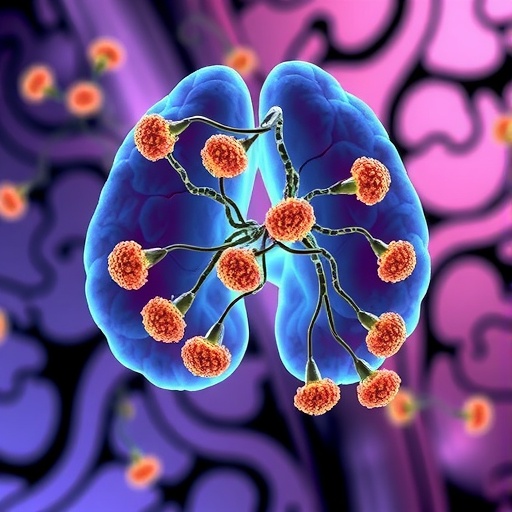
In the complex biological orchestra that governs energy balance in mammals, the hormone glucagon-like peptide-1 (GLP-1) holds a critical position, particularly within the central nervous system. Beyond its well-established peripheral roles in glucose metabolism and insulin secretion, GLP-1 plays an enigmatic role in the brain’s regulation of appetite and energy homeostasis. A recent groundbreaking study published in Nature Metabolism unveils novel mechanisms underpinning how central GLP-1 operates through precise neural circuits, linking the paraventricular hypothalamic nucleus (PVN) to the dorsal vagal complex (DVC) of the brainstem. This discovery not only deepens our understanding of fundamental neuroendocrine processes but may pave the way for innovative therapeutic strategies against obesity and metabolic disorders.
GLP-1 is secreted centrally by a unique population of neurons located specifically in the nucleus tractus solitarius (NTS), a brainstem structure previously known for its role in processing visceral sensory information. These neurons project widely and influence various regions involved in feeding control. Despite prior recognition of their appetite-suppressing capabilities, the precise synaptic mechanisms and downstream targets mediating GLP-1’s central anorectic effects have remained obscure. The present study elucidates a critical descending neuronal pathway where neurons expressing GLP-1 receptors in the PVN send glutamatergic projections directly to the dorsal vagal complex.
Using elegant neuroanatomical tracing combined with electrophysiological recording techniques in murine models, the researchers mapped the synaptic architecture of the PVN^GLP-1R→DVC pathway. Their data indicate that these synapses reliably release glutamate, the brain’s primary excitatory neurotransmitter, establishing an excitatory link between the hypothalamus and brainstem feeding centers. Intriguingly, synaptic transmission at these sites is not static; it is modulated dynamically by the local availability of GLP-1, which enhances glutamate release and synaptic strength.
.adsslot_GHZapNqlIc{width:728px !important;height:90px !important;}
@media(max-width:1199px){ .adsslot_GHZapNqlIc{width:468px !important;height:60px !important;}
}
@media(max-width:767px){ .adsslot_GHZapNqlIc{width:320px !important;height:50px !important;}
}
ADVERTISEMENT
The functional significance of this circuit was further demonstrated using chemogenetic tools that allow selective activation of PVN^GLP-1R→DVC neurons. Upon stimulation, a marked suppression of feeding behavior was observed, affirming the role of this pathway in appetite regulation. Importantly, the degree of suppression correlated with the animal’s energy state, suggesting that GLP-1’s efficacy in this circuitry is finely tuned to physiological hunger or satiety signals.
Digging deeper into the state-dependent properties of the circuit, the investigators found that under conditions of energy deficit—simulating hunger—the baseline synaptic strength of PVN^GLP-1R→DVC connections diminishes. Paradoxically, though synaptic efficacy is lower during hunger, these synapses exhibit a heightened sensitivity to GLP-1-mediated potentiation. This nuanced modulation could serve as a neural mechanism by which the brain adjusts feeding behavior flexibly in response to metabolic needs.
The study’s revelations extend into pathological realms as well. In murine models of obesity, the plasticity of the PVN^GLP-1R→DVC synapses becomes disrupted, with impaired synaptic adaptations to energy states. This aberrant synaptic regulation compromises the circuit’s capacity to respond appropriately to GLP-1 signals, potentially contributing to the dysregulated feeding behaviors and metabolic imbalances characteristic of obesity.
To corroborate the causal role of this neural pathway, optogenetic strategies were employed to selectively stimulate the PVN^GLP-1R→DVC projections with millisecond precision. Excitation of this circuit robustly suppressed food intake, but crucially, the effect was profoundly dependent on the animal’s current energy state. These findings underscore the importance of state-dependent synaptic plasticity for maintaining energy homeostasis and suggest that GLP-1 receptor responsiveness fluctuates with metabolic cues.
Equally compelling were experiments that interfered with synaptic transmission in this pathway. Blocking neurotransmitter release or genetically ablating GLP-1 receptors in presynaptic neurons led to notable impairments in metabolic health, including disrupted feeding patterns and altered body weight regulation. This underscores the indispensability of PVN^GLP-1R signaling to the dorsal vagal complex for normal appetite control and systemic energy balance.
At a cellular level, the researchers show that GLP-1 can modulate synaptic efficacy rapidly, implying involvement of membrane-bound GLP-1 receptors engaging intracellular signaling cascades that enhance glutamate release probability and/or postsynaptic receptor sensitivity. This synaptic facilitation likely integrates peripheral metabolic signals with central neural networks controlling behavior, embodying a crucial homeostatic feedback loop.
These insights shift the conceptual framework of central appetite regulation by highlighting a descending PVN-to-brainstem excitatory glutamatergic circuit under direct modulation by GLP-1. Such a mechanism bridges the hypothalamic regulatory hub with autonomic centers that orchestrate visceral functions, thus linking higher brain functions with the execution of energy intake behaviors.
The disruption observed in obesity models may reflect maladaptive plasticity or receptor desensitization in GLP-1 signaling pathways. This raises provocative questions about whether restoring or enhancing this synaptic communication could mitigate hyperphagia and metabolic disturbances. Therapeutic interventions targeting this axis could yield unprecedented precision in treating obesity by recalibrating brainstem circuits involved in appetite suppression.
Moreover, the state-dependent nature of synaptic modulation by GLP-1 suggests a highly adaptable neural substrate capable of fine-tuning appetite according to fluctuating energy demands. This flexibility likely prevents both under- and overconsumption, maintaining energy equilibrium across diverse physiological conditions. Decoding the molecular underpinnings of this plasticity represents an exciting frontier for neurobiological research.
In sum, this study by Wang, Savani, Lu, and colleagues reveals a previously unappreciated central pathway through which GLP-1 regulates feeding behavior via synaptic plasticity in the PVN^GLP-1R→DVC circuit. It delineates a vital neurobiological axis crucial for maintaining energy homeostasis, one that is compromised in metabolic diseases such as obesity. Understanding these state-dependent synaptic mechanisms offers a promising avenue for novel obesity treatments predicated on neuromodulation rather than peripheral metabolic enhancement alone.
The implications of these findings transcend basic neuroscience and metabolic physiology, providing a blueprint for future investigations into how brain circuits integrate hormonal signals to guide complex behaviors like feeding. Given the growing global burden of obesity and related metabolic disorders, such insights could catalyze transformative advances in clinical management, offering hope for more effective and targeted interventions.
With the innovative use of chemogenetics and optogenetics, coupled with detailed synaptic analyses, this research sets a new benchmark for dissecting neural circuits in metabolic control. It exemplifies how precise manipulation of defined neural populations can unravel the nuanced interplays between brain, hormone, and behavior that sustain life’s energy demands.
In conclusion, the identification of the PVN^GLP-1R→DVC glutamatergic descending circuit as a modulated node in feeding suppression unravels a critical piece in the puzzle of energy homeostasis. By elucidating the synaptic dynamics underpinning this circuit’s state-dependent function, the study opens a novel chapter in neuroendocrinology and metabolic research, with vast potential to inform therapeutic innovation in combating obesity and metabolic syndrome.
Subject of Research: Central neural circuits regulating energy homeostasis via GLP-1 receptor-mediated synaptic modulation.
Article Title: State-dependent central synaptic regulation by GLP-1 is essential for energy homeostasis.
Article References:
Wang, L., Savani, R.H., Lu, Y. et al. State-dependent central synaptic regulation by GLP-1 is essential for energy homeostasis. Nat Metab (2025). https://doi.org/10.1038/s42255-025-01305-x
Image Credits: AI Generated
Tags: appetite-suppressing hormonescentral nervous system appetite regulationdorsal vagal complex interactionenergy homeostasis mechanismsGLP-1 and energy balanceglutamatergic projections in feeding controlinnovative obesity treatment strategiesneuroendocrine processes in obesityneurons in nucleus tractus solitariusobesity and metabolic disorder therapiesparaventricular hypothalamic nucleus rolesynaptic mechanisms of GLP-1



